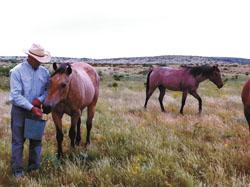 Ron and Janet Helm started a retirement home for horses a couple of years ago on their Van Horn, Texas, ranch. So far, they have had 13 horses brought to them between the ages of 2 and 24. As word has gotten out, horse owners from around the country have started to contact them about their unique service.
Ron and Janet Helm started a retirement home for horses a couple of years ago on their Van Horn, Texas, ranch. So far, they have had 13 horses brought to them between the ages of 2 and 24. As word has gotten out, horse owners from around the country have started to contact them about their unique service.
“We aren’t an adoption or rescue facility,” Helm emphasizes. Clients pay $200/month (or $5,000 if the horse is 20 or older) and the Helms only take geldings and open mares with papers that the horses have had all the necessary shots and are disease free.
So far, most of the tenants are former performance horses – hunters, jumpers and eventers – that are past their peak.
“They (horse owners) don’t want to put the horse down and they don’t want to hold it in a small run for the rest of its life,” Helm says. “They feel this is a better life for their horses. We’re strictly native rangeland; we have 12,000 acres.”
Their service also saves money for people who might be paying $450/month or more for stable fees.
When a horse comes to the ranch, it’s kept separate for a transition time to acclimate to the new life, which includes grazing for meals rather than being fed twice a day. Helm recalls one 7-year-old mare that had been born and raised in a small paddock with only a 100-ft. run. She had no idea how to run when she arrived, but a year later she outran all the mares in her herd.
Currently, the Helms separate the horses into three groups. When a new horse is introduced to the group, it takes about 3 hrs. for the horses to work out the pecking order, Helm notes.
Helm, who has more than three decades of experience raising cattle and horses, keeps an eye on the “retirees”. He and his wife have frequent contact with them, walking through the herds with range cubes to keep them people friendly. Helm handles minor medical needs, and calls the veterinarian if there are problems he can’t handle (which the client pays for).
However, he notes, being on the range eliminates many of the issues horses deal with in confined quarters such as colic, cribbing and hoof problems. The rocky terrain of the Davis Mountains foothills keeps hooves in good shape, and the semi-arid climate reduces parasitic problems. At an elevation of 3,000 to 4,000 ft., winter temperatures only drop to the 20’s and seldom climb past the mid-90’s in summer.
Canyons, ravines and trees provide shade and wind protection. Water is available about every half mile piped from wells to water tanks.
Helm notes that clients sign a contract acknowledging that he has no responsibility for accidents.
“The hardest thing I did not foresee is convincing owners that a horse will do better here than in a confined space,” Helm says. “Owners miss the horse more than the horses miss the owners.”
Owners can come visit their horses after the transition period, and the Helms post photos on Facebook.
So far, none of the retirees are from Texas. They have come from states including Pennsylvania, New York, Florida and New Jersey. With plenty of land, the Helms anticipate they could accommodate up to 150 horses.
1-800-834-9665
Horses Retire To Good Life On Texas Range
FARM SHOW Magazine » Horses Retire To Good Life On Texas Range
Horses Retire To Good Life On Texas Range
